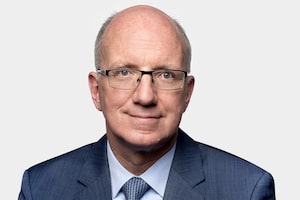
Cenovus CEO Alex Pourbaix speaks at a news conference in Calgary on Jan. 30, 2020.Jeff McIntosh/The Canadian Press
Cenovus Energy Inc. CVE-T is taking an estimated $1.38-billion hit to exit its oil hedges, accepting the short-term pain of shutting down the program to regain exposure to soaring oil prices and rejoin the ranks of Canada’s senior energy companies.
Cenovus, one of the largest operators in Alberta’s oil sands, announced plans Monday to suspend hedging strategies that locked in future prices for a portion of its production. The Calgary-based company said: “Given the strength of Cenovus’s balance sheet and liquidity position, the company has determined these programs are no longer required to support financial resilience.”
Cenovus put what it describes as a “risk management” program in place before the war in Ukraine sent oil prices to US$100 a barrel from US$50 a year ago. Based on current commodity prices, the company said exiting will mean booking a $970-million loss in the first quarter of this year and an additional $410-million loss in the second quarter.
While the dollar figures are large, the fact that Cenovus can afford to make this move shows how chief executive Alex Pourbaix has fixed the company’s finances since acquiring rival Husky Energy Inc. for $4.78-billion in March, 2021.
None of Cenovus’s peers in the oil patch – producers such as Canadian Natural Resources Ltd., Suncor Energy Inc. and Imperial Oil Ltd. – currently hedge oil production. As a result, shares in the country’s largest energy companies outperformed Cenovus shares over the past year, as they fully benefited from the rally in commodity prices.
Cenovus was the outlier for a simple reason: After closing the Husky acquisition, the company carried $15.9-billion in debt. Until recently, Mr. Pourbaix simply couldn’t afford to have cash flows dry up owing to a decline in oil prices.
Cenovus Energy loss widens on nearly $2-billion impairment, shares fall
A sustained downturn in energy markets – which routinely experience gut-wrenching ones – would leave Cenovus short of the cash it needed to pay back loans. If Cenovus failed to make interest payments, creditors could take control.
By pre-selling a portion of its future oil production at set prices – that’s what the hedging program does – Cenovus locked in the cash it needed to pay creditors. By hedging, Mr. Pourbaix managed the risk Cenovus could go bankrupt, wiping out shareholders.
Over the past year, Cenovus paid down almost $4-billion in debt, in part by using cash from asset sales. Looking ahead, analysts estimate the company will generate more than $7-billion of cash this year, based on selling oil for US$95 a barrel. In this environment, the risks associated with paying down debt fell away, while the hedging program became increasingly expensive.
“In a rapidly rising oil price environment, like the first quarter, these hedging losses will be material,” said analyst Jason Bouvier at Scotiabank in a report on Cenovus published last month. At the time, he said investors needed to look past the “sticker shock” of these losses and focus on the company’s shrinking debts and soaring cash flow. On Monday, Mr. Bouvier followed up with a report that said: “Cenovus is suspending its hedging program due to the strength of its balance sheet.”
If they gave Olympic medals for losing money on exiting hedges, Cenovus wouldn’t even get near the podium. Barrick Gold Corp. took a US$5.6-billion charge in 2009 when it shut down a bullion hedging program and was forced to sell US$4-billion of stock to pay for the move.
Junior and intermediate energy companies will continue to hedge a portion of their production to ensure they’ve got the cash needed to fund exploration and new projects, according to analysts, and investors in these companies look at the programs as a necessary cost when valuing their stocks.
However, investors in Canada’s largest energy plays want to take full advantage of a bull market for oil. They don’t want repeated sticker shocks, in the form of ongoing losses from hedging. By aggressively paying down debt and shutting down the only hedging program among senior oil companies, Mr. Pourbaix showed that Cenovus has fully digested the Husky acquisition.
Your time is valuable. Have the Top Business Headlines newsletter conveniently delivered to your inbox in the morning or evening. Sign up today.
 Andrew Willis
Andrew Willis